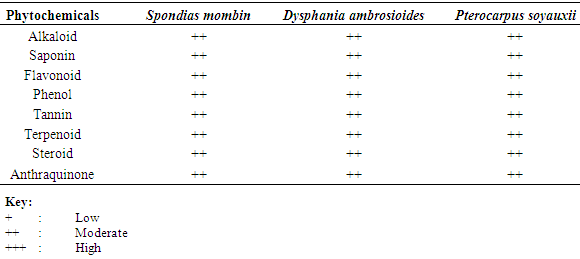-
Paper Information
- Paper Submission
-
Journal Information
- About This Journal
- Editorial Board
- Current Issue
- Archive
- Author Guidelines
- Contact Us
International Journal of Plant Research
p-ISSN: 2163-2596 e-ISSN: 2163-260X
2016; 6(1): 7-12
doi:10.5923/j.plant.20160601.02

Medicinal Plants Used for the Treatment of Rheumatism by Amahor People of Edo State, Nigeria
Erhenhi A. H.
Department of Botany, Faculty of Science, Delta State University, Abraka, Nigeria
Correspondence to: Erhenhi A. H. , Department of Botany, Faculty of Science, Delta State University, Abraka, Nigeria.
| Email: |  |
Copyright © 2016 Scientific & Academic Publishing. All Rights Reserved.
This work is licensed under the Creative Commons Attribution International License (CC BY).
http://creativecommons.org/licenses/by/4.0/

A study on the medicinal plants used for the treatment of rheumatism by Amahor people in Igueben Local Government Area, Edo State was carried out. Trips were made to the community to traditional health attendants to obtain information about plants used for the treatment of rheumatism. The plants were locally identified in the field and scientific identification and classification was carried out using pictorial annotated text and herbarium. Three (3) plant species: Spondias mombin L., Dysphania ambrosioides Taub and Pterocarpus soyauxii Jacq belonging to the family Anacardiaceae, Amaranthaceae and Fabaceae respectively were collected. The common and local names were also recorded. Parts of the plant used for the treatment of rheumatism were leaves, stem, bark and root which are prepared in different forms with addition of other materials like native chalk and fresh palm fruits before administration. Qualitative screening of the plants collected showed the presence phytochemicals such as alkaloid, saponin, flavonoid, phenol, tannin, terpenoid, steroid and anthraquinone at moderate concentration. The present study showed that there is absolute knowledge on the use of plant for the treatment of rheumatism by the people of Amahor community in Igueben Local Government Area of Edo State, Nigeria.
Keywords: Rheumatism, Amahor, Medicinal plants
Cite this paper: Erhenhi A. H. , Medicinal Plants Used for the Treatment of Rheumatism by Amahor People of Edo State, Nigeria, International Journal of Plant Research, Vol. 6 No. 1, 2016, pp. 7-12. doi: 10.5923/j.plant.20160601.02.
1. Introduction
- Many people in rural areas have been using medicinal plants for the treatment of various diseases and ailment. Rheumatism is common among the aged both in rural and urban areas. This disease condition makes the victims to find it difficult to sit or stand quickly without experiencing acute pains. Rheumatism is chronic, progressive, disabling autoimmune disease characterized by systemic inflammation of joints, damaging cartilage and bone around the joints. It is a systemic disease which means that it can affect the whole body and internal organs such as lungs, heart and eyes. Although numbers of synthetic drugs are being used as standard treatment for rheumatoid arthritis but they have adverse effect that can compromise the therapeutic treatment (Kaur et al., 2012).Unfortunately, there is still no effective known medicinal treatment that cures rheumatoid arthritis as the modern medicine can only treat the symptoms of this disease that means to relieve pain and inflammation of joints (Kaur et al., 2012). It is possible to use the herbs and plants in various forms in order to relieve the pain and inflammation in the joints. Several medicinal plants including including Acteae racemosa, Zingiber officinale (Kaur et al., 2012), Asmina triloba, Citrus aurantifolia and Psidium guajava (Nwachukwu et al., 2010) have shown anti rheumatoid arthritis properties. These plants and plant product with significant advantages are used for the treatment of rheumatoid arthritis. Based on the significance of plants in the treatment of various health issues including rheumatism, this study was carried out to evaluate the phytochemical composition of plants used for the treatment of rheumatism by Amahor people of Igueben Local Government Area of Edo State, Nigeria.
2. Materials and Method
- Description of Study AreaAmahor is an Esan speaking community which is located in Igueben Local Government Area of Edo State in the Niger Delta Region. The community lies between latitude 6° 45’ and 6° 48’ E and longitude 6° 12’ and 6° 14’ N; with an area of 15.31 km2. The community is a lowland rainforest located in Igueben and is drained by Eban, Orhionmwon Rivers and Agbokoi stream. Amahor community comprised of six quarters (Eguare, Ukpeko, Idumodin, Obodeko, Idunmogo, and Waterside) (Aremu et al., 2009).Collection of Plant MaterialsField visit was made to Amahor community located at Igueben Local Government Area of Edo State for collection of ethnobotanical data on the use of plant for the treatment and management of rheumatism by the locals. The most vital tools used in this investigation were resource persons such as known herbalists, aged men and women and other individuals who have the knowledge of medicinal plants and their efficacy. The information were collected via oral interview and the data of the plant prescribed, part of the plant used, detailed information about the mode of preparation, form of usage either fresh or dried and method of administration about the plant stated by the indigenes were recorded on field note book. Identification of Plants SpeciesField identification was carried out with the aid of the resource persons who helped in the collection, identifying and giving the local names for some of the plants used for treatment and management of rheumatism. The plant samples were transferred to the Department of Botany Laboratory of Delta State University, Abraka for proper identification and scientific classification using textbook of Flora of West Tropical Africa by Hutchinson and Dalziel (1968); Outlines and Pictures of Medicinal plants in Nigeria by Odugbemi (2008) and Handbook of African Medicinal Plants by Iwu (1993).Phytochemical AnalysisPhytochemical screening of extract was carried out to determine the presence of secondary metabolites using the method of Hero and Zirak (2013).
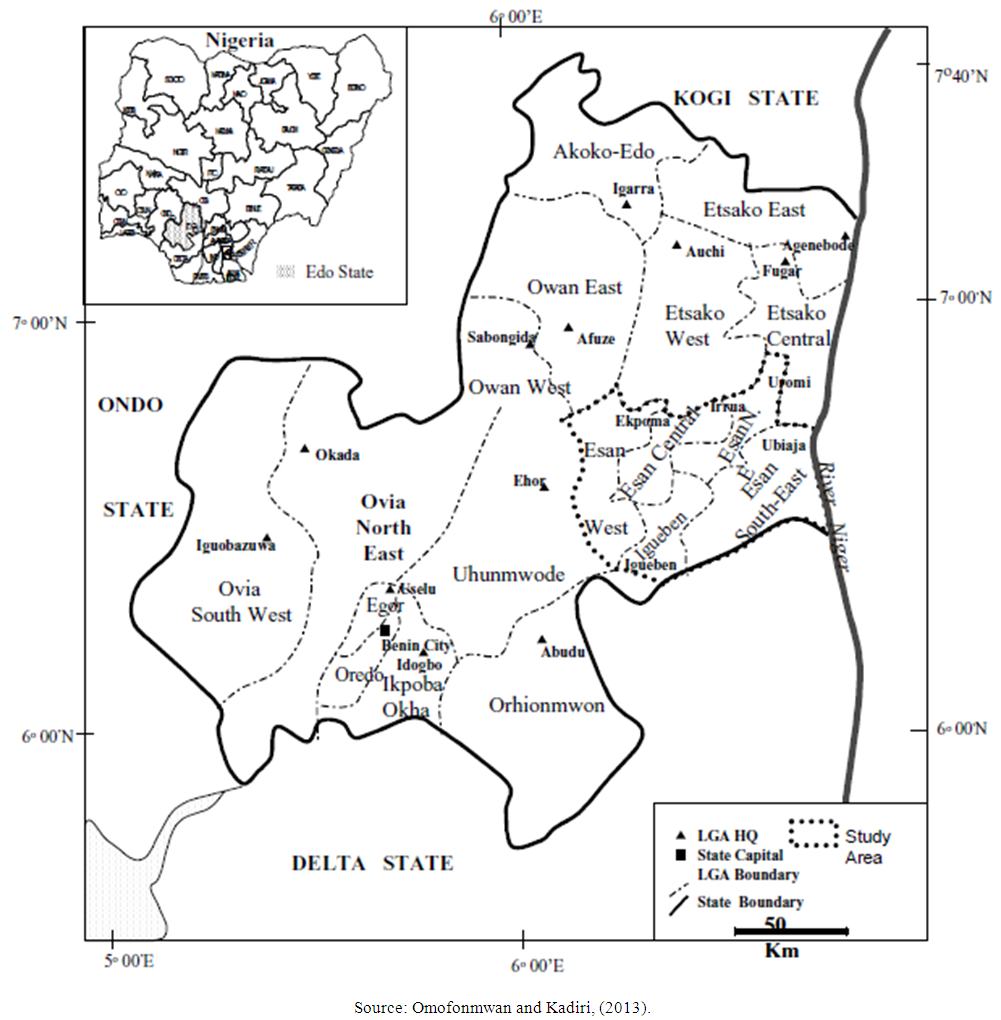 | Figure 1. Map of Edo State showing the study area |
3. Results
- Medicinal Plant SurveyThe field survey of medicinal plant revealed that rheumatism is an ailment which is recognized by the people of Amahor community as the ailment is commonly referred to as “Okonghue” by the local indigenes. The people also recognized the implications of the ailment on human health and wellbeing, hence the need for effective management of the ailment.The study revealed a total of three plants which are of great importance in the treatment of rheumatism as given by traditional health practitioners and indigenes of the community. The names and families of the plant species recorded and their local names as well as methods of preparation and administration are presented in Table 1. The table shows the family, local names and common names of the plant species recorded. The three families recorded include Anacardiaceae, Amaranthaceae and Fabaceae.The present study thus gives a report on the use of plant in the treatment of rheumatism by the people of Amahor, Edo State with a view of revealing the quantitative level of phytochemicals present in the plants which might be attributed to their medicinal properties.
|
 Method of Preparation and Administration:Collect the fresh leaves and peel the bark of the tree as well. Pound the bark of the tree properly to smooth form. Squeeze the leave and add to the pounded bark. Add some quantity of native chalk (Orue) to the bark and leave mixture. Rub the paste on the spot of the rheumatism daily.
Method of Preparation and Administration:Collect the fresh leaves and peel the bark of the tree as well. Pound the bark of the tree properly to smooth form. Squeeze the leave and add to the pounded bark. Add some quantity of native chalk (Orue) to the bark and leave mixture. Rub the paste on the spot of the rheumatism daily. Method of Preparation and Administration:Dig the root of the plant and collect some portion, also collect fresh leaves. Rinse both the root and the leaves properly to remove sand and dirt. Add enough quantity of the root and leaves in a pot and add enough quantity of banga (fresh palm nuts). Put the pot on the fire and allow it to boil properly. Use it to prepare soup and consume.
Method of Preparation and Administration:Dig the root of the plant and collect some portion, also collect fresh leaves. Rinse both the root and the leaves properly to remove sand and dirt. Add enough quantity of the root and leaves in a pot and add enough quantity of banga (fresh palm nuts). Put the pot on the fire and allow it to boil properly. Use it to prepare soup and consume.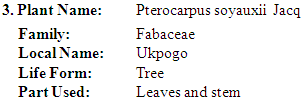 Method of Preparation and Administration:Collect both the leaves and stem of the plant. In the stem, peel of the hard bark and collect the inner portion of it. Pound both the inner portion of the stem and the leaves together without applying water or other liquid. Use the pounded portion to rub the part of the body where the rheumatism pain is affected.
Method of Preparation and Administration:Collect both the leaves and stem of the plant. In the stem, peel of the hard bark and collect the inner portion of it. Pound both the inner portion of the stem and the leaves together without applying water or other liquid. Use the pounded portion to rub the part of the body where the rheumatism pain is affected. 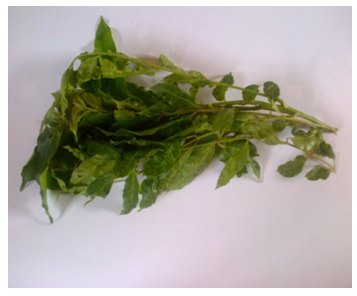 | Plate 1. Spondias mombin L |
 | Plate 2. Dysphania ambrosiodes Taub |
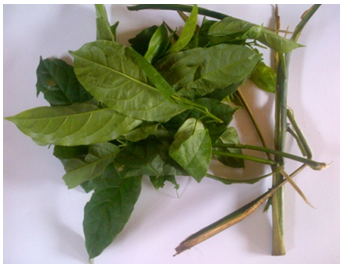 | Plate 3. Pterocarpus soyauxii Jacq |
|
4. Discussion
- Medicinal plants of both herb and trees have been reported in this study to be effective in the management and treatment of rheumatism by the Amahor people of Edo State. Some of these plants exist in the wild, while others are domesticated. Also, the basic active ingredients used for treating various ailments are accumulated in the different parts of plants such as leaves, root, bark and stem. The plant species recorded in this study has not been reported for the treatment of rheumatism. Although, several other plants from the same family and several other families have been reported for the treatment and management of rheumatism by various researchers, this include the studies of Harish et al. (2010) reported that all parts of Ocimum basilicum L. including seed are boiled with mustard oil and the prepared lotion is applied on joint pain for two to four days. Jiofack et al. (2010) reported the use of medicinal plants in the treatment of rheumatism to include Alchornea floribunda leaves, stem and maceration and Zingiber officinale leaves, seeds and stem. Similarly, Kaur et al. (2012) reported the use of plants such as Acteae racemosa and Zingiber officinale in the management of rheumatism. The use of Aframomum melegueta in the treatment of rheumatism has also been reported by Enti (2002) who stated that the spice is mixed with other herbs for the treatment of body pains and rheumatism. The anti-rheumatic potentials of the plants recorded in this study may be attributed to the presence of bioactive compounds which are present at varying concentrations as reported by Bishnu et al, (2009). Research has shown that many of these indigenous plants contain bioactive compounds that exhibit anatomical and physiological activities against bacteria and other microorganisms and are also used as precursors for the synthesis of useful drugs (Bishnu et al, 2009; Edeoga et al., 2005).The results of the phytochemical analysis showed the presence of such as alkaloids, tannins, flavonoids, phenolic compounds, anthraquinones, steroids and saponins in moderate concentrations I the three plant species. This is similar to the report of Njoku and Akumefula (2007) who reported the presence of tannins, saponins, alkaloids, phenols and flavonoids on Spondias mombin at moderate concentrations. Also, Adejumo et al. (2011) reported the phytochemical composition of Dysphania ambrosioides and with positive result on the presence of alkaloids, saponins and tannins.The biological function of flavonoids include protection against allergies, inflammation, platelets aggregation microbes, ulcer, vineses and tumors (Okwu and Okwu, 2004). Flavonoids represent the most common and widely distributed groups of plant phenolics. Saponins in plant are responsible for the possession of hemolytic property which is responsible for the medicinal potential of the plant. Alkaloids are the most efficient therapeutically significant plant substance. Pure isolated alkaloids and the synthetic derivatives are used as the basic medicinal agent because of their analgesic antispasmodic and bacterial properties. Tannins have been reported to have astringent properties which hasten the healing of wounds and inflamed mucous membrane.The presence of tannins in the leaves of Spondias Mombin can support its strong use for healing of wounds, varicose ulcers, hemorrhoids, frost-bite and burn in herbal medicine (Adejumo et al., 2011). The presence of phenolic compounds in the leaves of Spondias Mombin shows that the plant may have antimicrobial potential. This is because phenols and phenolic compounds have been extensively used in disinfections and remain the standards with which other bactercides are compared (Okwu, 2001).
5. Conclusions
- The present study showed that there is absolute knowledge on the use of plant for the treatment of rheumatism by the people of Amahor community in Igueben Local Government Area of Edo State, Nigeria. Moreover, the existing knowledge on traditional uses of plants are on fast declining because lack of interest of local youth to learn the traditional knowledge from the old herbal healer. Scientific investigations through the evaluation of plants for their biological activity and isolation of active constituents responsible for their medicinal properties for joint diseases like rheumatism and other health issues need to be carried out in various pharmaceutical industries and National laboratories which will give a lead to develop new natural drug molecules so as to reach the benefit of research for the welfare of human beings.
 Abstract
Abstract Reference
Reference Full-Text PDF
Full-Text PDF Full-text HTML
Full-text HTML
